Principles of Microeconomics, Chapter 5: Elasticity Assignment
VerifiedAdded on 2022/11/24
|43
|8899
|63
Homework Assignment
AI Summary
This document provides solutions to a microeconomics assignment focusing on the concept of elasticity. The assignment covers various aspects of elasticity, including price elasticity of demand, perfectly elastic and inelastic demand, and unit elastic demand. It includes multiple-choice questions and calculations using the midpoint formula to determine elasticity values. The questions assess the understanding of how changes in price affect quantity demanded and total revenue. The document also explores concepts such as the law of demand, and the relationship between elasticity and the shape of the demand curve. The solutions provide detailed explanations and calculations to aid in understanding the core principles of microeconomics and elasticity. Furthermore, the assignment includes questions on calculating elasticity using the midpoint formula and interpreting the results, reinforcing the analytical skills needed for economic analysis. This assignment is ideal for students studying microeconomics and seeking to improve their understanding of elasticity and related concepts.
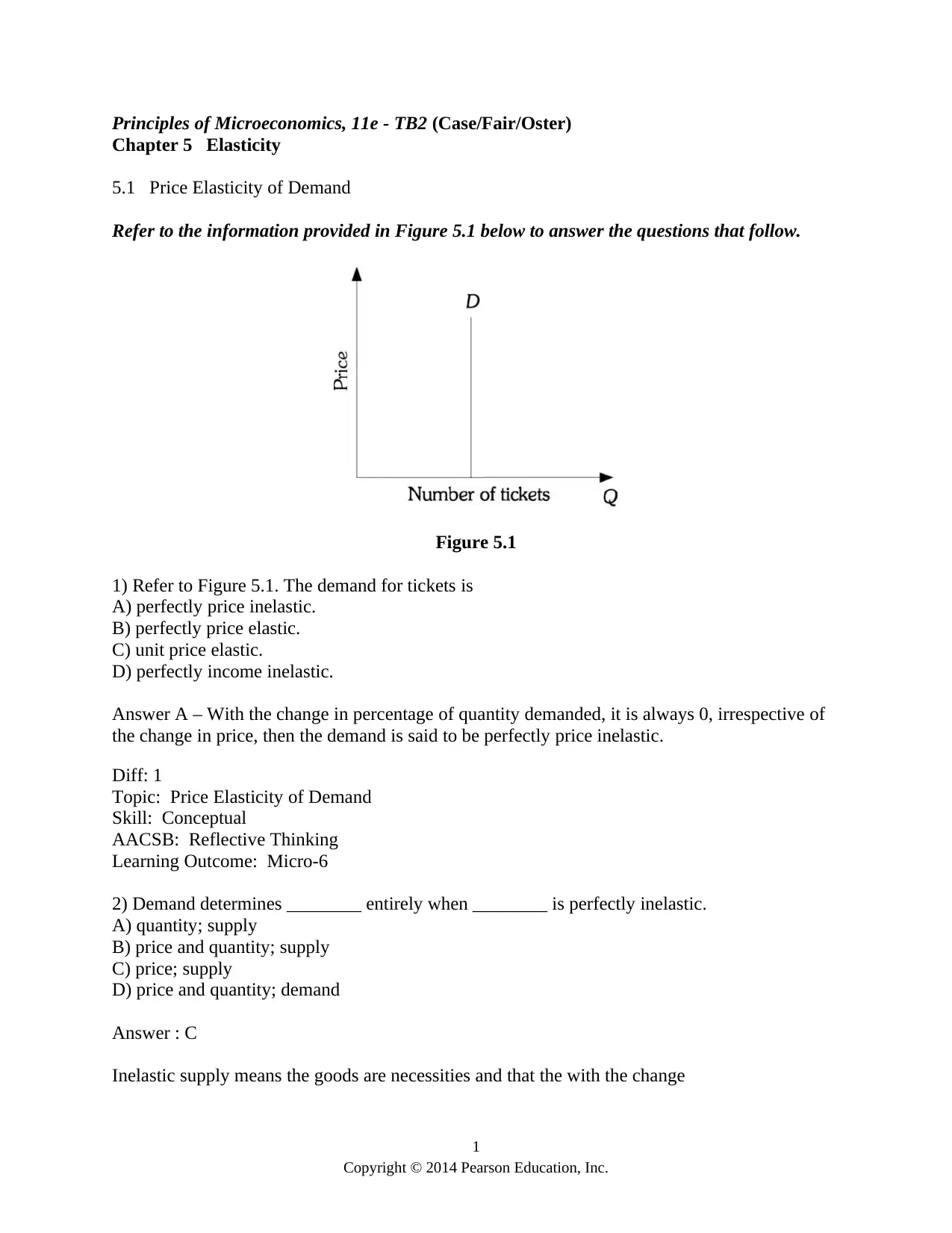
Principles of Microeconomics, 11e - TB2 (Case/Fair/Oster)
Chapter 5 Elasticity
5.1 Price Elasticity of Demand
Refer to the information provided in Figure 5.1 below to answer the questions that follow.
Figure 5.1
1) Refer to Figure 5.1. The demand for tickets is
A) perfectly price inelastic.
B) perfectly price elastic.
C) unit price elastic.
D) perfectly income inelastic.
Answer A – With the change in percentage of quantity demanded, it is always 0, irrespective of
the change in price, then the demand is said to be perfectly price inelastic.
Diff: 1
Topic: Price Elasticity of Demand
Skill: Conceptual
AACSB: Reflective Thinking
Learning Outcome: Micro-6
2) Demand determines ________ entirely when ________ is perfectly inelastic.
A) quantity; supply
B) price and quantity; supply
C) price; supply
D) price and quantity; demand
Answer : C
Inelastic supply means the goods are necessities and that the with the change
1
Copyright © 2014 Pearson Education, Inc.
Chapter 5 Elasticity
5.1 Price Elasticity of Demand
Refer to the information provided in Figure 5.1 below to answer the questions that follow.
Figure 5.1
1) Refer to Figure 5.1. The demand for tickets is
A) perfectly price inelastic.
B) perfectly price elastic.
C) unit price elastic.
D) perfectly income inelastic.
Answer A – With the change in percentage of quantity demanded, it is always 0, irrespective of
the change in price, then the demand is said to be perfectly price inelastic.
Diff: 1
Topic: Price Elasticity of Demand
Skill: Conceptual
AACSB: Reflective Thinking
Learning Outcome: Micro-6
2) Demand determines ________ entirely when ________ is perfectly inelastic.
A) quantity; supply
B) price and quantity; supply
C) price; supply
D) price and quantity; demand
Answer : C
Inelastic supply means the goods are necessities and that the with the change
1
Copyright © 2014 Pearson Education, Inc.
Paraphrase This Document
Need a fresh take? Get an instant paraphrase of this document with our AI Paraphraser
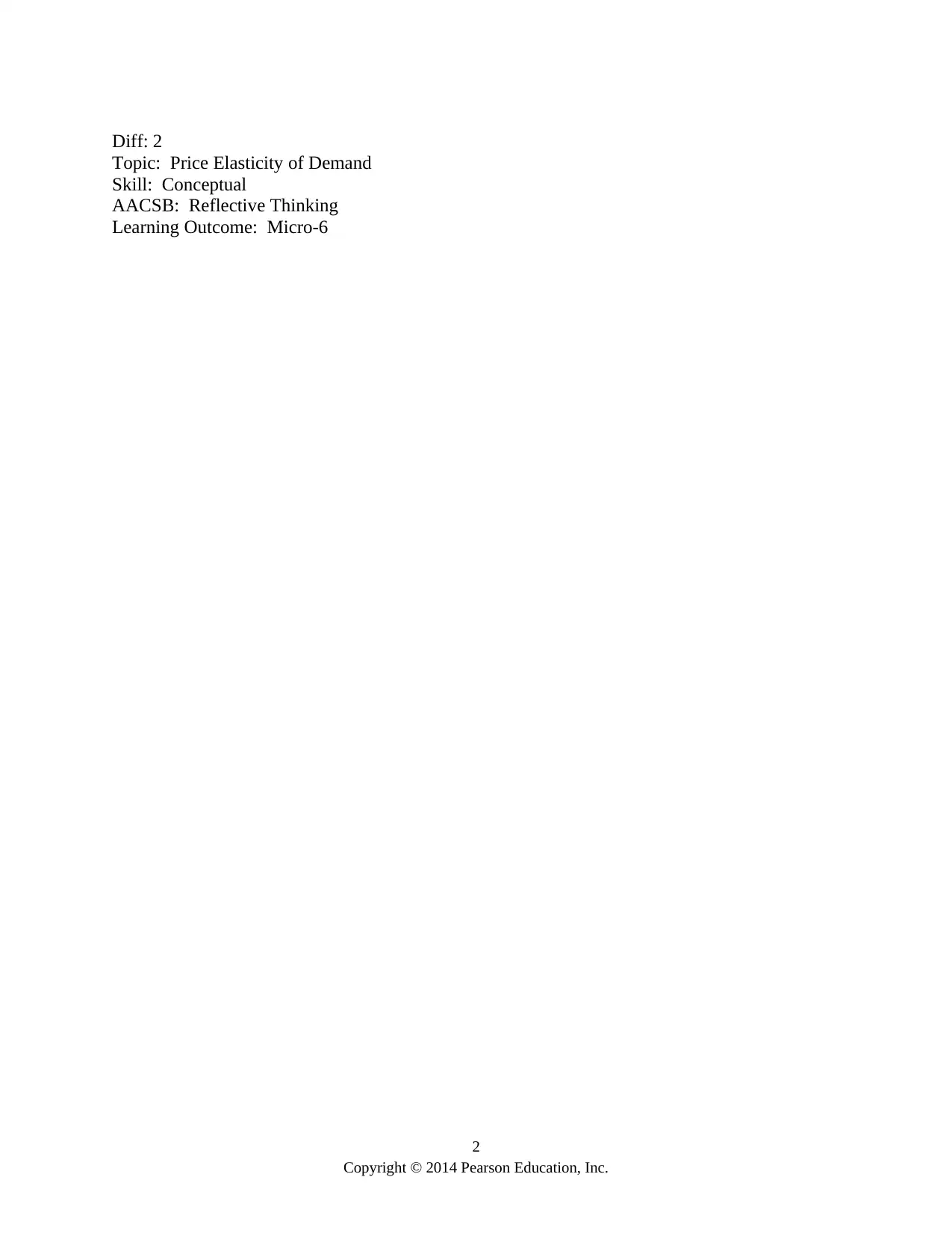
Diff: 2
Topic: Price Elasticity of Demand
Skill: Conceptual
AACSB: Reflective Thinking
Learning Outcome: Micro-6
2
Copyright © 2014 Pearson Education, Inc.
Topic: Price Elasticity of Demand
Skill: Conceptual
AACSB: Reflective Thinking
Learning Outcome: Micro-6
2
Copyright © 2014 Pearson Education, Inc.
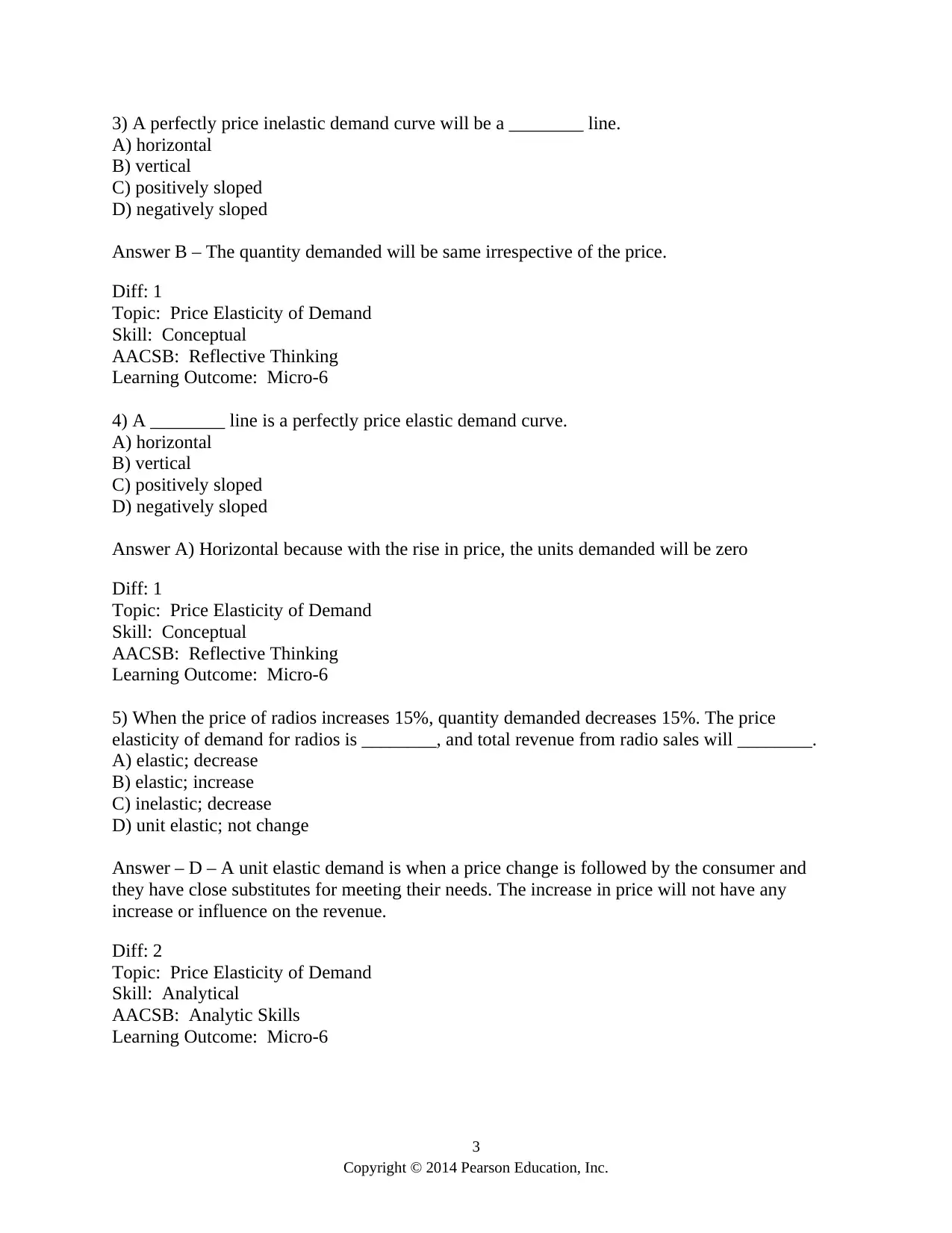
3) A perfectly price inelastic demand curve will be a ________ line.
A) horizontal
B) vertical
C) positively sloped
D) negatively sloped
Answer B – The quantity demanded will be same irrespective of the price.
Diff: 1
Topic: Price Elasticity of Demand
Skill: Conceptual
AACSB: Reflective Thinking
Learning Outcome: Micro-6
4) A ________ line is a perfectly price elastic demand curve.
A) horizontal
B) vertical
C) positively sloped
D) negatively sloped
Answer A) Horizontal because with the rise in price, the units demanded will be zero
Diff: 1
Topic: Price Elasticity of Demand
Skill: Conceptual
AACSB: Reflective Thinking
Learning Outcome: Micro-6
5) When the price of radios increases 15%, quantity demanded decreases 15%. The price
elasticity of demand for radios is ________, and total revenue from radio sales will ________.
A) elastic; decrease
B) elastic; increase
C) inelastic; decrease
D) unit elastic; not change
Answer – D – A unit elastic demand is when a price change is followed by the consumer and
they have close substitutes for meeting their needs. The increase in price will not have any
increase or influence on the revenue.
Diff: 2
Topic: Price Elasticity of Demand
Skill: Analytical
AACSB: Analytic Skills
Learning Outcome: Micro-6
3
Copyright © 2014 Pearson Education, Inc.
A) horizontal
B) vertical
C) positively sloped
D) negatively sloped
Answer B – The quantity demanded will be same irrespective of the price.
Diff: 1
Topic: Price Elasticity of Demand
Skill: Conceptual
AACSB: Reflective Thinking
Learning Outcome: Micro-6
4) A ________ line is a perfectly price elastic demand curve.
A) horizontal
B) vertical
C) positively sloped
D) negatively sloped
Answer A) Horizontal because with the rise in price, the units demanded will be zero
Diff: 1
Topic: Price Elasticity of Demand
Skill: Conceptual
AACSB: Reflective Thinking
Learning Outcome: Micro-6
5) When the price of radios increases 15%, quantity demanded decreases 15%. The price
elasticity of demand for radios is ________, and total revenue from radio sales will ________.
A) elastic; decrease
B) elastic; increase
C) inelastic; decrease
D) unit elastic; not change
Answer – D – A unit elastic demand is when a price change is followed by the consumer and
they have close substitutes for meeting their needs. The increase in price will not have any
increase or influence on the revenue.
Diff: 2
Topic: Price Elasticity of Demand
Skill: Analytical
AACSB: Analytic Skills
Learning Outcome: Micro-6
3
Copyright © 2014 Pearson Education, Inc.
⊘ This is a preview!⊘
Do you want full access?
Subscribe today to unlock all pages.

Trusted by 1+ million students worldwide
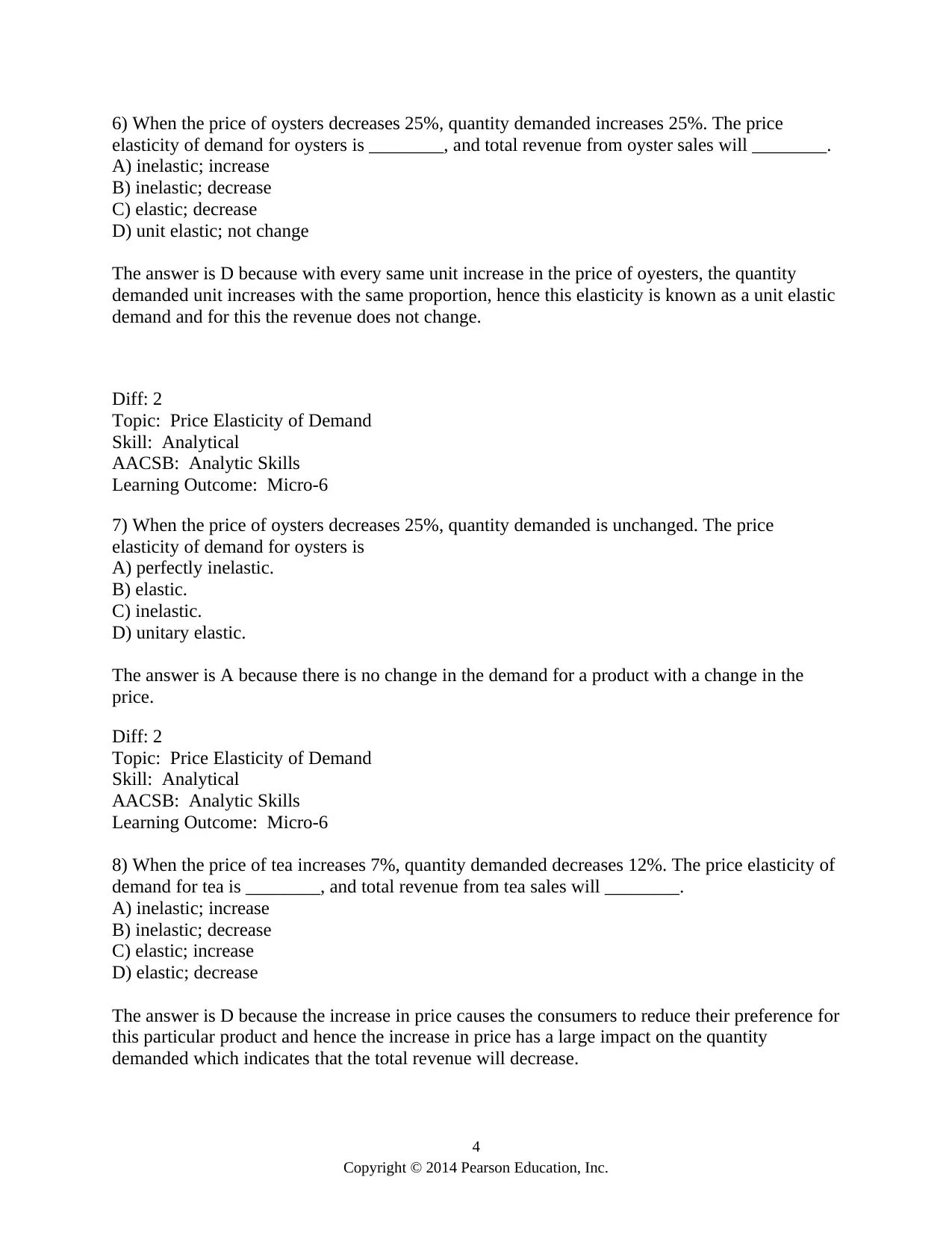
6) When the price of oysters decreases 25%, quantity demanded increases 25%. The price
elasticity of demand for oysters is ________, and total revenue from oyster sales will ________.
A) inelastic; increase
B) inelastic; decrease
C) elastic; decrease
D) unit elastic; not change
The answer is D because with every same unit increase in the price of oyesters, the quantity
demanded unit increases with the same proportion, hence this elasticity is known as a unit elastic
demand and for this the revenue does not change.
Diff: 2
Topic: Price Elasticity of Demand
Skill: Analytical
AACSB: Analytic Skills
Learning Outcome: Micro-6
7) When the price of oysters decreases 25%, quantity demanded is unchanged. The price
elasticity of demand for oysters is
A) perfectly inelastic.
B) elastic.
C) inelastic.
D) unitary elastic.
The answer is A because there is no change in the demand for a product with a change in the
price.
Diff: 2
Topic: Price Elasticity of Demand
Skill: Analytical
AACSB: Analytic Skills
Learning Outcome: Micro-6
8) When the price of tea increases 7%, quantity demanded decreases 12%. The price elasticity of
demand for tea is ________, and total revenue from tea sales will ________.
A) inelastic; increase
B) inelastic; decrease
C) elastic; increase
D) elastic; decrease
The answer is D because the increase in price causes the consumers to reduce their preference for
this particular product and hence the increase in price has a large impact on the quantity
demanded which indicates that the total revenue will decrease.
4
Copyright © 2014 Pearson Education, Inc.
elasticity of demand for oysters is ________, and total revenue from oyster sales will ________.
A) inelastic; increase
B) inelastic; decrease
C) elastic; decrease
D) unit elastic; not change
The answer is D because with every same unit increase in the price of oyesters, the quantity
demanded unit increases with the same proportion, hence this elasticity is known as a unit elastic
demand and for this the revenue does not change.
Diff: 2
Topic: Price Elasticity of Demand
Skill: Analytical
AACSB: Analytic Skills
Learning Outcome: Micro-6
7) When the price of oysters decreases 25%, quantity demanded is unchanged. The price
elasticity of demand for oysters is
A) perfectly inelastic.
B) elastic.
C) inelastic.
D) unitary elastic.
The answer is A because there is no change in the demand for a product with a change in the
price.
Diff: 2
Topic: Price Elasticity of Demand
Skill: Analytical
AACSB: Analytic Skills
Learning Outcome: Micro-6
8) When the price of tea increases 7%, quantity demanded decreases 12%. The price elasticity of
demand for tea is ________, and total revenue from tea sales will ________.
A) inelastic; increase
B) inelastic; decrease
C) elastic; increase
D) elastic; decrease
The answer is D because the increase in price causes the consumers to reduce their preference for
this particular product and hence the increase in price has a large impact on the quantity
demanded which indicates that the total revenue will decrease.
4
Copyright © 2014 Pearson Education, Inc.
Paraphrase This Document
Need a fresh take? Get an instant paraphrase of this document with our AI Paraphraser
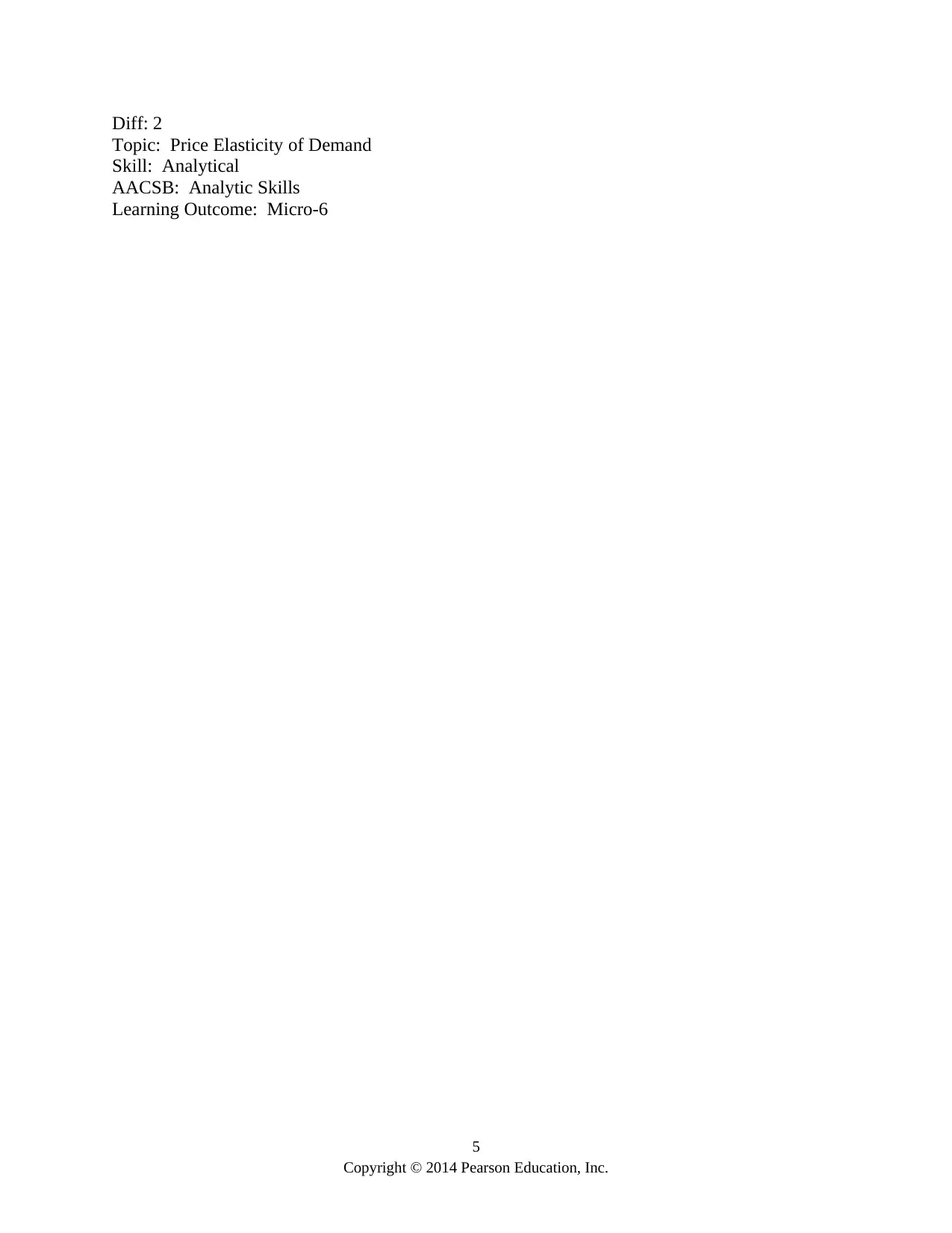
Diff: 2
Topic: Price Elasticity of Demand
Skill: Analytical
AACSB: Analytic Skills
Learning Outcome: Micro-6
5
Copyright © 2014 Pearson Education, Inc.
Topic: Price Elasticity of Demand
Skill: Analytical
AACSB: Analytic Skills
Learning Outcome: Micro-6
5
Copyright © 2014 Pearson Education, Inc.
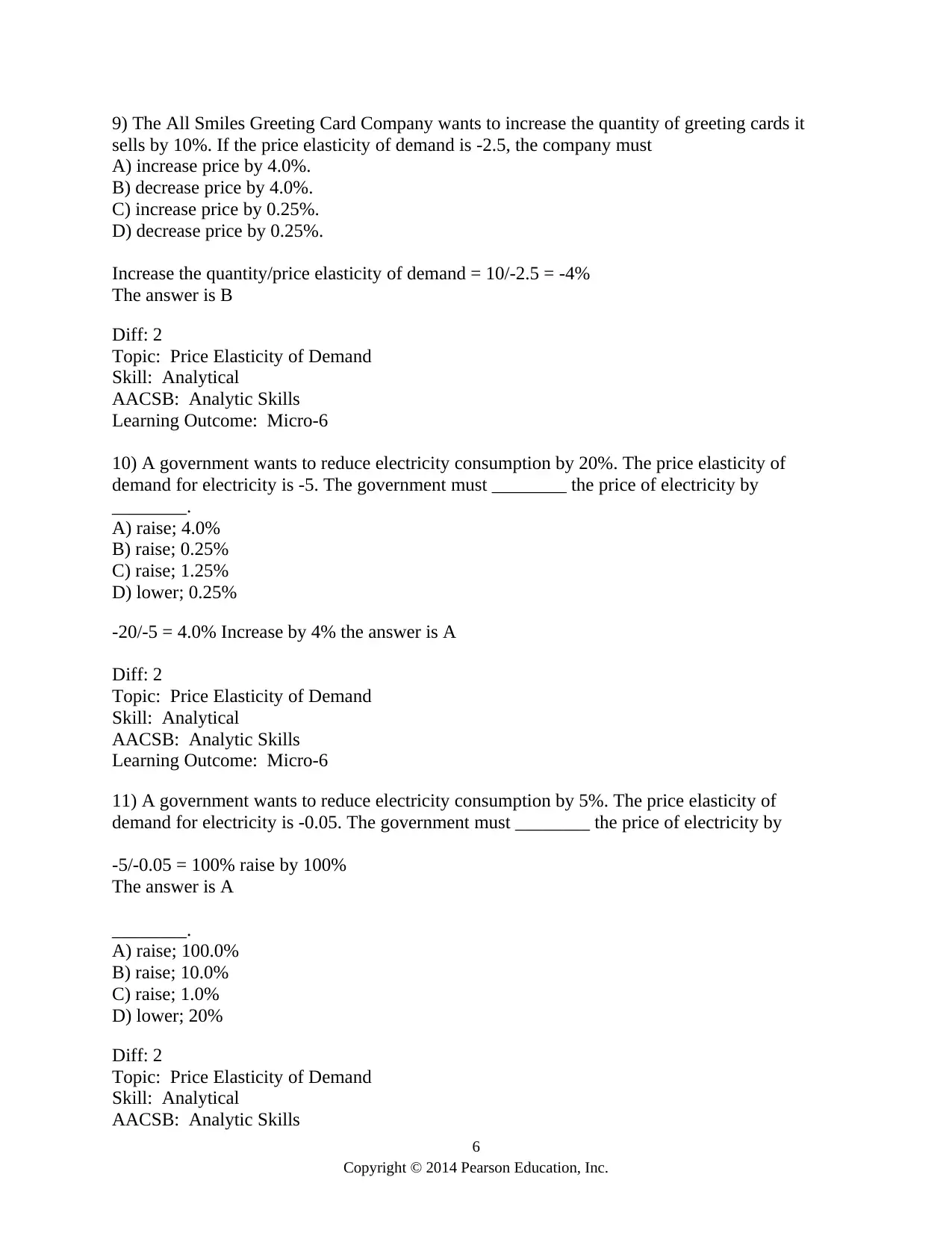
9) The All Smiles Greeting Card Company wants to increase the quantity of greeting cards it
sells by 10%. If the price elasticity of demand is -2.5, the company must
A) increase price by 4.0%.
B) decrease price by 4.0%.
C) increase price by 0.25%.
D) decrease price by 0.25%.
Increase the quantity/price elasticity of demand = 10/-2.5 = -4%
The answer is B
Diff: 2
Topic: Price Elasticity of Demand
Skill: Analytical
AACSB: Analytic Skills
Learning Outcome: Micro-6
10) A government wants to reduce electricity consumption by 20%. The price elasticity of
demand for electricity is -5. The government must ________ the price of electricity by
________.
A) raise; 4.0%
B) raise; 0.25%
C) raise; 1.25%
D) lower; 0.25%
-20/-5 = 4.0% Increase by 4% the answer is A
Diff: 2
Topic: Price Elasticity of Demand
Skill: Analytical
AACSB: Analytic Skills
Learning Outcome: Micro-6
11) A government wants to reduce electricity consumption by 5%. The price elasticity of
demand for electricity is -0.05. The government must ________ the price of electricity by
-5/-0.05 = 100% raise by 100%
The answer is A
________.
A) raise; 100.0%
B) raise; 10.0%
C) raise; 1.0%
D) lower; 20%
Diff: 2
Topic: Price Elasticity of Demand
Skill: Analytical
AACSB: Analytic Skills
6
Copyright © 2014 Pearson Education, Inc.
sells by 10%. If the price elasticity of demand is -2.5, the company must
A) increase price by 4.0%.
B) decrease price by 4.0%.
C) increase price by 0.25%.
D) decrease price by 0.25%.
Increase the quantity/price elasticity of demand = 10/-2.5 = -4%
The answer is B
Diff: 2
Topic: Price Elasticity of Demand
Skill: Analytical
AACSB: Analytic Skills
Learning Outcome: Micro-6
10) A government wants to reduce electricity consumption by 20%. The price elasticity of
demand for electricity is -5. The government must ________ the price of electricity by
________.
A) raise; 4.0%
B) raise; 0.25%
C) raise; 1.25%
D) lower; 0.25%
-20/-5 = 4.0% Increase by 4% the answer is A
Diff: 2
Topic: Price Elasticity of Demand
Skill: Analytical
AACSB: Analytic Skills
Learning Outcome: Micro-6
11) A government wants to reduce electricity consumption by 5%. The price elasticity of
demand for electricity is -0.05. The government must ________ the price of electricity by
-5/-0.05 = 100% raise by 100%
The answer is A
________.
A) raise; 100.0%
B) raise; 10.0%
C) raise; 1.0%
D) lower; 20%
Diff: 2
Topic: Price Elasticity of Demand
Skill: Analytical
AACSB: Analytic Skills
6
Copyright © 2014 Pearson Education, Inc.
⊘ This is a preview!⊘
Do you want full access?
Subscribe today to unlock all pages.

Trusted by 1+ million students worldwide
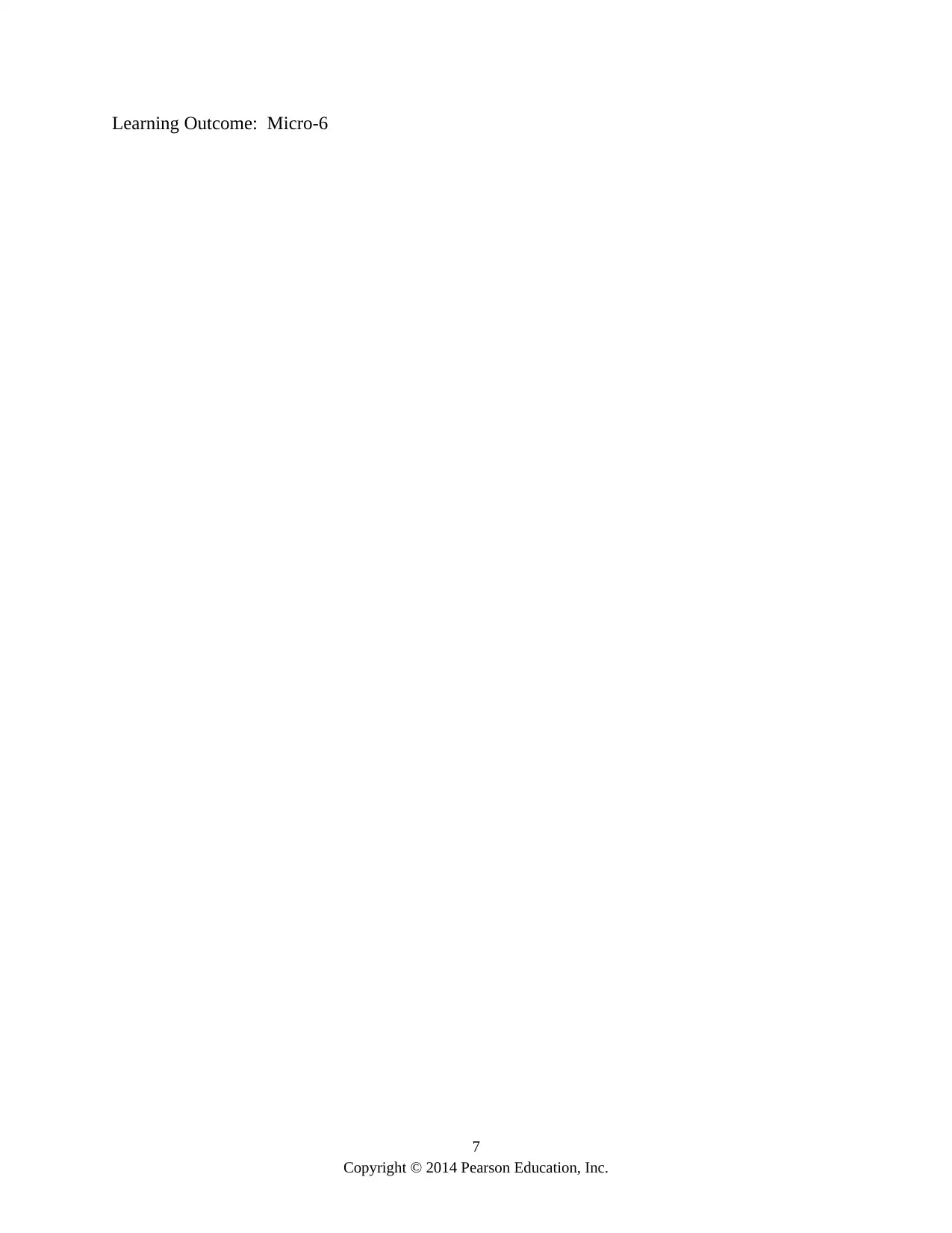
Learning Outcome: Micro-6
7
Copyright © 2014 Pearson Education, Inc.
7
Copyright © 2014 Pearson Education, Inc.
Paraphrase This Document
Need a fresh take? Get an instant paraphrase of this document with our AI Paraphraser
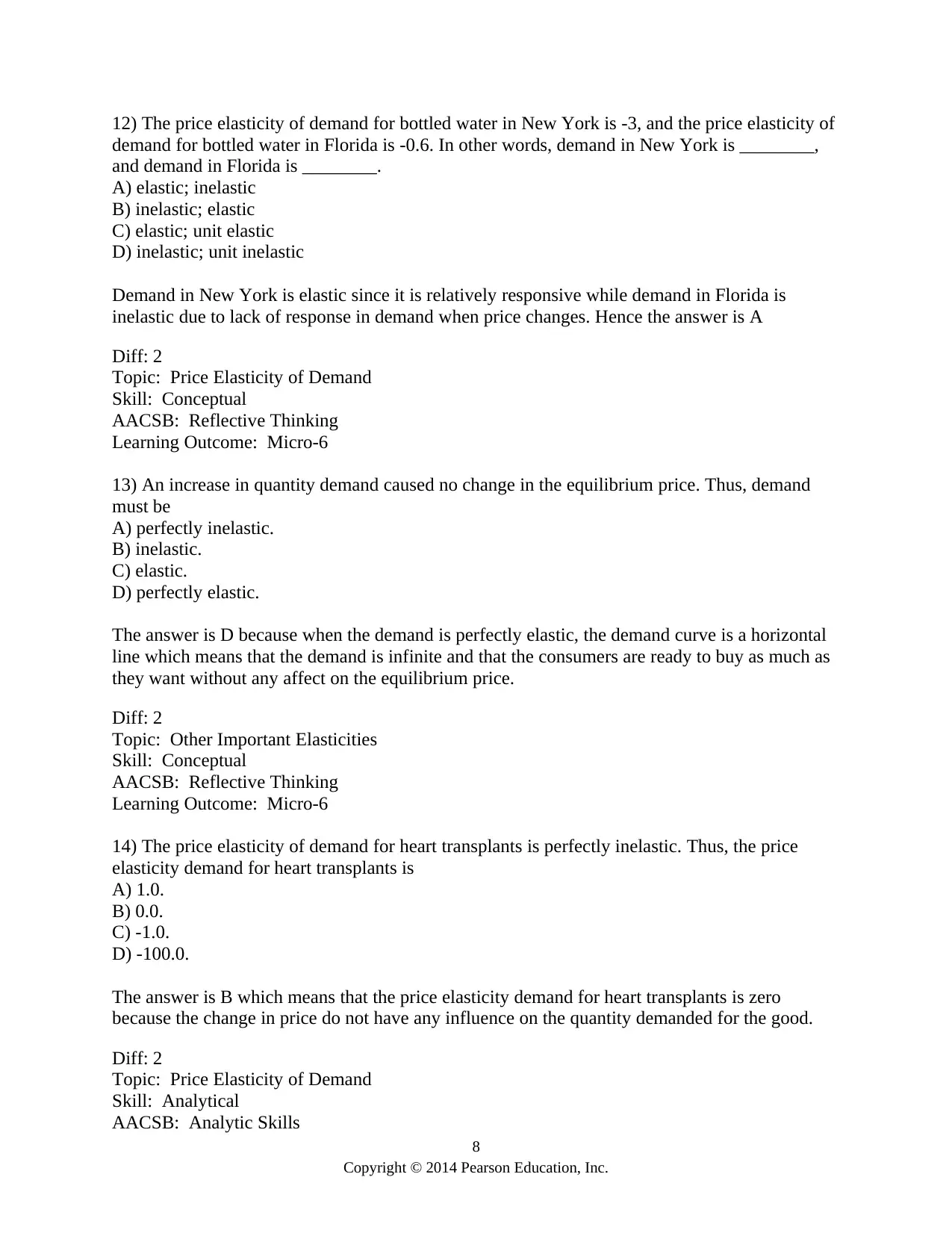
12) The price elasticity of demand for bottled water in New York is -3, and the price elasticity of
demand for bottled water in Florida is -0.6. In other words, demand in New York is ________,
and demand in Florida is ________.
A) elastic; inelastic
B) inelastic; elastic
C) elastic; unit elastic
D) inelastic; unit inelastic
Demand in New York is elastic since it is relatively responsive while demand in Florida is
inelastic due to lack of response in demand when price changes. Hence the answer is A
Diff: 2
Topic: Price Elasticity of Demand
Skill: Conceptual
AACSB: Reflective Thinking
Learning Outcome: Micro-6
13) An increase in quantity demand caused no change in the equilibrium price. Thus, demand
must be
A) perfectly inelastic.
B) inelastic.
C) elastic.
D) perfectly elastic.
The answer is D because when the demand is perfectly elastic, the demand curve is a horizontal
line which means that the demand is infinite and that the consumers are ready to buy as much as
they want without any affect on the equilibrium price.
Diff: 2
Topic: Other Important Elasticities
Skill: Conceptual
AACSB: Reflective Thinking
Learning Outcome: Micro-6
14) The price elasticity of demand for heart transplants is perfectly inelastic. Thus, the price
elasticity demand for heart transplants is
A) 1.0.
B) 0.0.
C) -1.0.
D) -100.0.
The answer is B which means that the price elasticity demand for heart transplants is zero
because the change in price do not have any influence on the quantity demanded for the good.
Diff: 2
Topic: Price Elasticity of Demand
Skill: Analytical
AACSB: Analytic Skills
8
Copyright © 2014 Pearson Education, Inc.
demand for bottled water in Florida is -0.6. In other words, demand in New York is ________,
and demand in Florida is ________.
A) elastic; inelastic
B) inelastic; elastic
C) elastic; unit elastic
D) inelastic; unit inelastic
Demand in New York is elastic since it is relatively responsive while demand in Florida is
inelastic due to lack of response in demand when price changes. Hence the answer is A
Diff: 2
Topic: Price Elasticity of Demand
Skill: Conceptual
AACSB: Reflective Thinking
Learning Outcome: Micro-6
13) An increase in quantity demand caused no change in the equilibrium price. Thus, demand
must be
A) perfectly inelastic.
B) inelastic.
C) elastic.
D) perfectly elastic.
The answer is D because when the demand is perfectly elastic, the demand curve is a horizontal
line which means that the demand is infinite and that the consumers are ready to buy as much as
they want without any affect on the equilibrium price.
Diff: 2
Topic: Other Important Elasticities
Skill: Conceptual
AACSB: Reflective Thinking
Learning Outcome: Micro-6
14) The price elasticity of demand for heart transplants is perfectly inelastic. Thus, the price
elasticity demand for heart transplants is
A) 1.0.
B) 0.0.
C) -1.0.
D) -100.0.
The answer is B which means that the price elasticity demand for heart transplants is zero
because the change in price do not have any influence on the quantity demanded for the good.
Diff: 2
Topic: Price Elasticity of Demand
Skill: Analytical
AACSB: Analytic Skills
8
Copyright © 2014 Pearson Education, Inc.
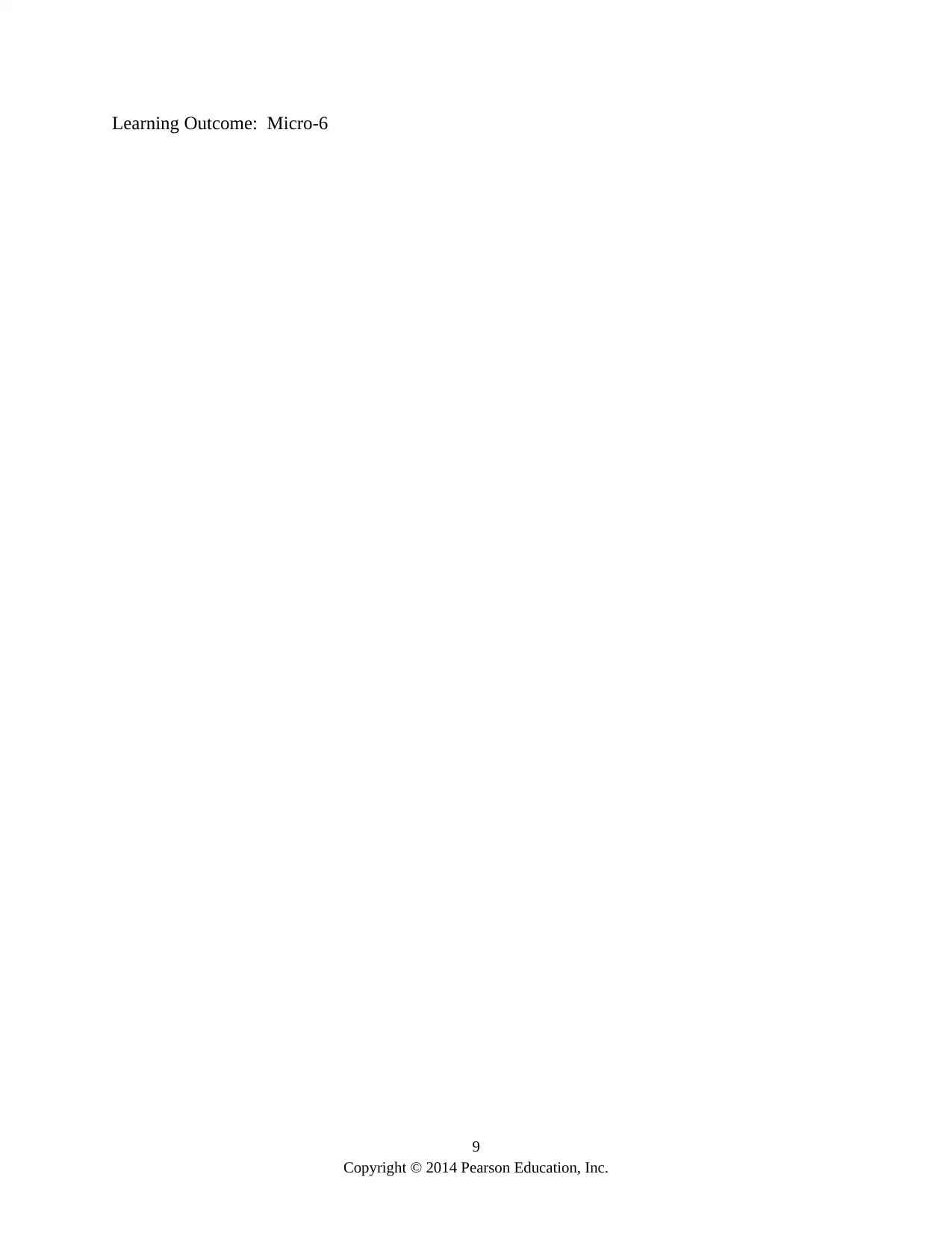
Learning Outcome: Micro-6
9
Copyright © 2014 Pearson Education, Inc.
9
Copyright © 2014 Pearson Education, Inc.
⊘ This is a preview!⊘
Do you want full access?
Subscribe today to unlock all pages.

Trusted by 1+ million students worldwide
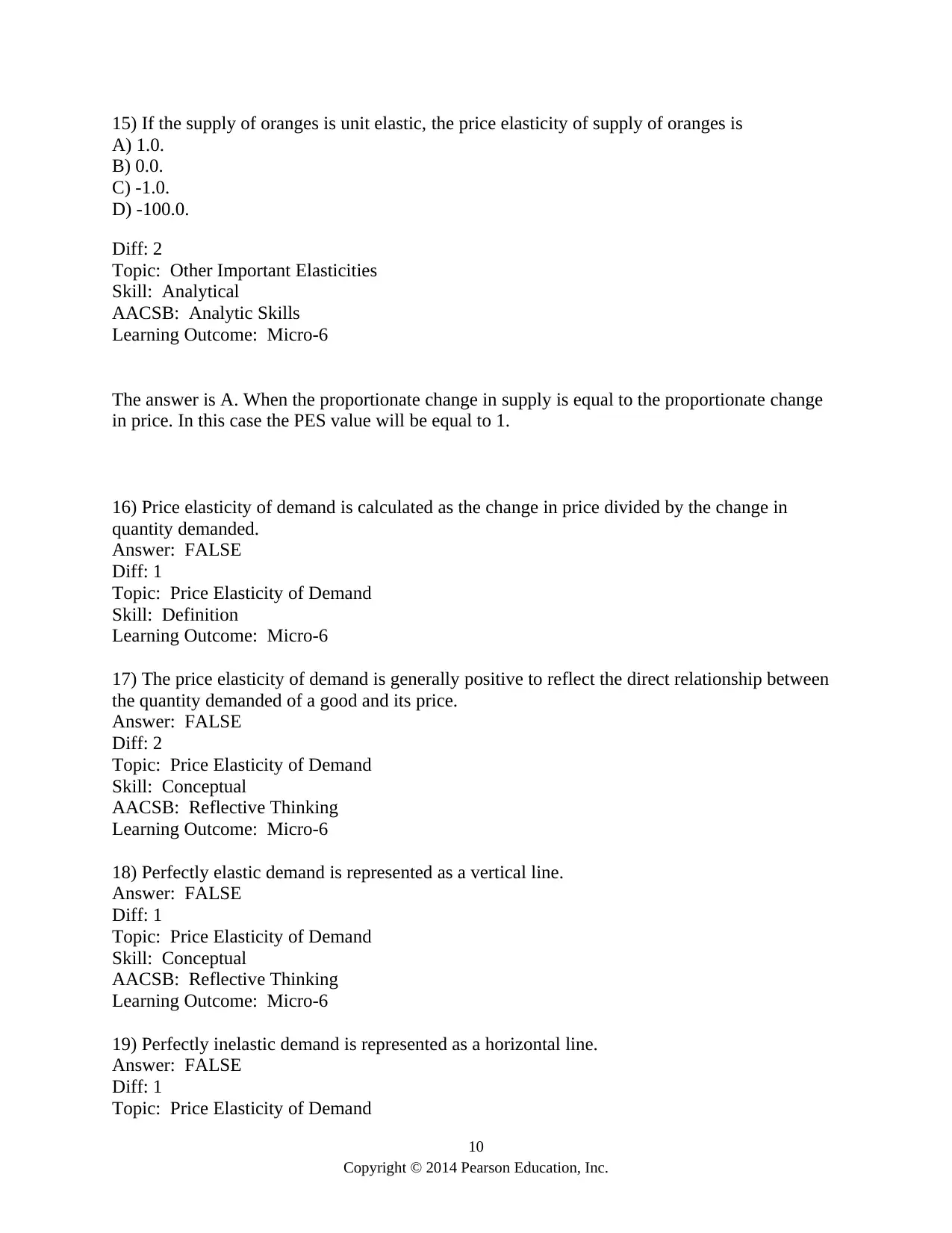
15) If the supply of oranges is unit elastic, the price elasticity of supply of oranges is
A) 1.0.
B) 0.0.
C) -1.0.
D) -100.0.
Diff: 2
Topic: Other Important Elasticities
Skill: Analytical
AACSB: Analytic Skills
Learning Outcome: Micro-6
The answer is A. When the proportionate change in supply is equal to the proportionate change
in price. In this case the PES value will be equal to 1.
16) Price elasticity of demand is calculated as the change in price divided by the change in
quantity demanded.
Answer: FALSE
Diff: 1
Topic: Price Elasticity of Demand
Skill: Definition
Learning Outcome: Micro-6
17) The price elasticity of demand is generally positive to reflect the direct relationship between
the quantity demanded of a good and its price.
Answer: FALSE
Diff: 2
Topic: Price Elasticity of Demand
Skill: Conceptual
AACSB: Reflective Thinking
Learning Outcome: Micro-6
18) Perfectly elastic demand is represented as a vertical line.
Answer: FALSE
Diff: 1
Topic: Price Elasticity of Demand
Skill: Conceptual
AACSB: Reflective Thinking
Learning Outcome: Micro-6
19) Perfectly inelastic demand is represented as a horizontal line.
Answer: FALSE
Diff: 1
Topic: Price Elasticity of Demand
10
Copyright © 2014 Pearson Education, Inc.
A) 1.0.
B) 0.0.
C) -1.0.
D) -100.0.
Diff: 2
Topic: Other Important Elasticities
Skill: Analytical
AACSB: Analytic Skills
Learning Outcome: Micro-6
The answer is A. When the proportionate change in supply is equal to the proportionate change
in price. In this case the PES value will be equal to 1.
16) Price elasticity of demand is calculated as the change in price divided by the change in
quantity demanded.
Answer: FALSE
Diff: 1
Topic: Price Elasticity of Demand
Skill: Definition
Learning Outcome: Micro-6
17) The price elasticity of demand is generally positive to reflect the direct relationship between
the quantity demanded of a good and its price.
Answer: FALSE
Diff: 2
Topic: Price Elasticity of Demand
Skill: Conceptual
AACSB: Reflective Thinking
Learning Outcome: Micro-6
18) Perfectly elastic demand is represented as a vertical line.
Answer: FALSE
Diff: 1
Topic: Price Elasticity of Demand
Skill: Conceptual
AACSB: Reflective Thinking
Learning Outcome: Micro-6
19) Perfectly inelastic demand is represented as a horizontal line.
Answer: FALSE
Diff: 1
Topic: Price Elasticity of Demand
10
Copyright © 2014 Pearson Education, Inc.
Paraphrase This Document
Need a fresh take? Get an instant paraphrase of this document with our AI Paraphraser
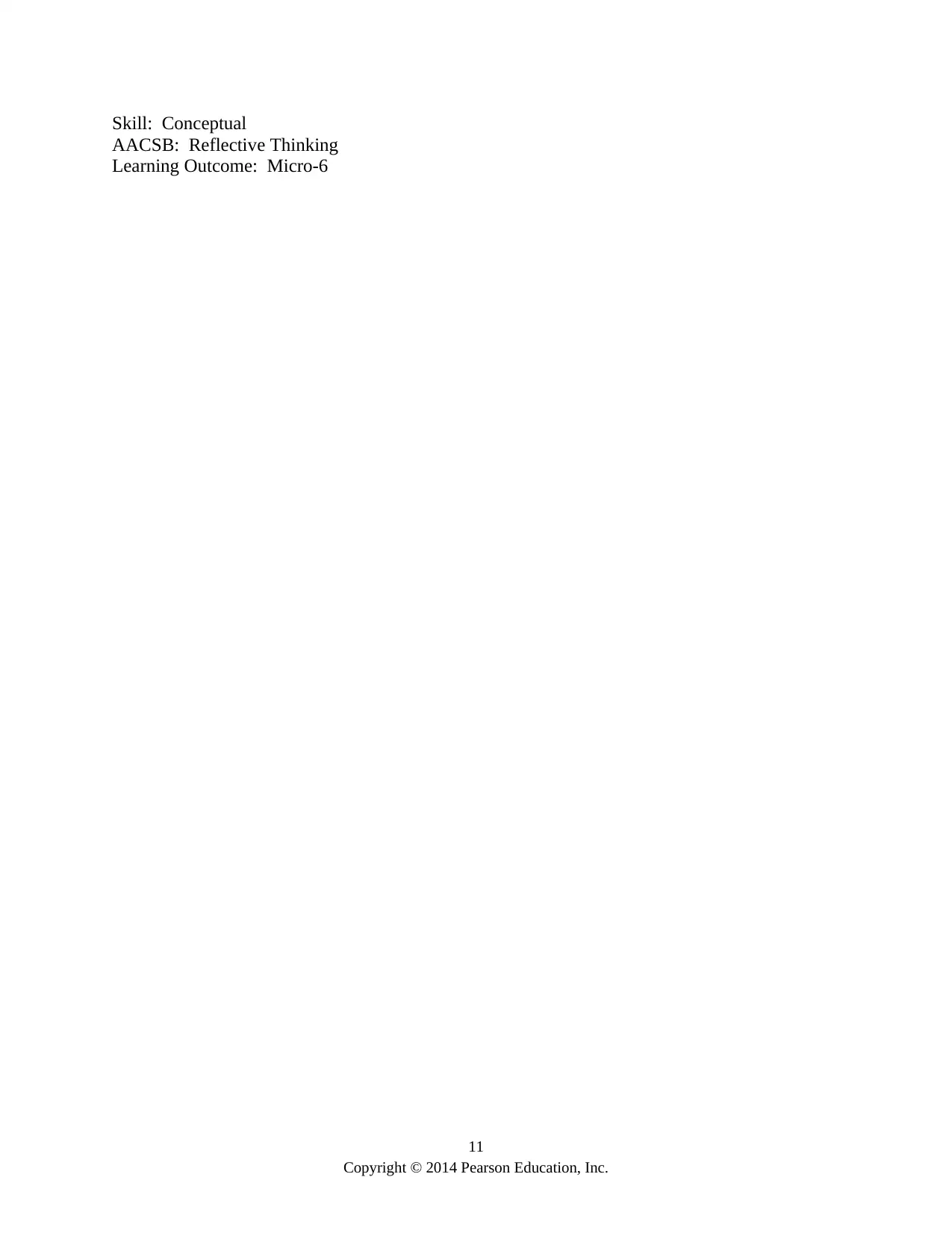
Skill: Conceptual
AACSB: Reflective Thinking
Learning Outcome: Micro-6
11
Copyright © 2014 Pearson Education, Inc.
AACSB: Reflective Thinking
Learning Outcome: Micro-6
11
Copyright © 2014 Pearson Education, Inc.
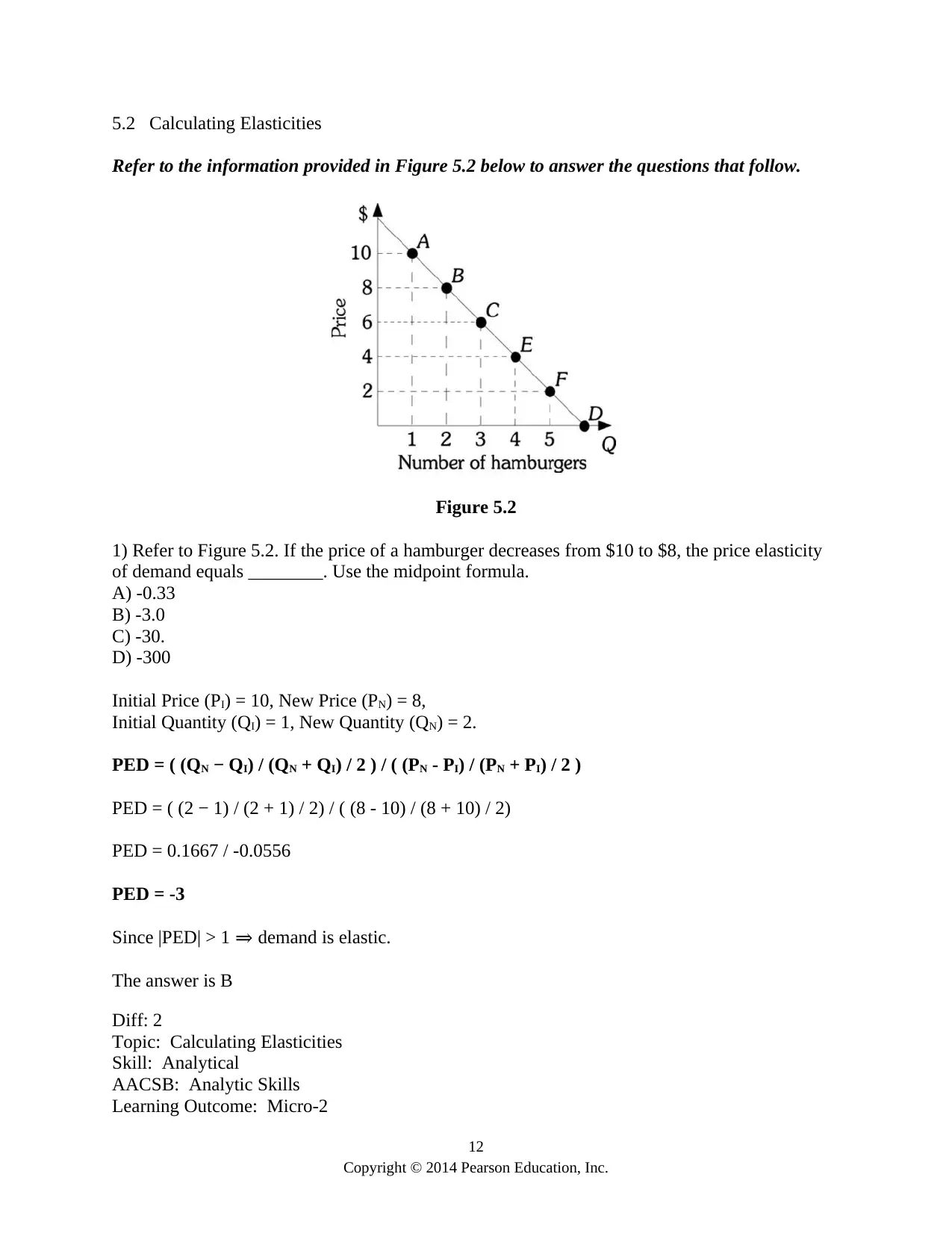
5.2 Calculating Elasticities
Refer to the information provided in Figure 5.2 below to answer the questions that follow.
Figure 5.2
1) Refer to Figure 5.2. If the price of a hamburger decreases from $10 to $8, the price elasticity
of demand equals ________. Use the midpoint formula.
A) -0.33
B) -3.0
C) -30.
D) -300
Initial Price (PI) = 10, New Price (PN) = 8,
Initial Quantity (QI) = 1, New Quantity (QN) = 2.
PED = ( (QN − QI) / (QN + QI) / 2 ) / ( (PN - PI) / (PN + PI) / 2 )
PED = ( (2 − 1) / (2 + 1) / 2) / ( (8 - 10) / (8 + 10) / 2)
PED = 0.1667 / -0.0556
PED = -3
Since |PED| > 1 ⇒ demand is elastic.
The answer is B
Diff: 2
Topic: Calculating Elasticities
Skill: Analytical
AACSB: Analytic Skills
Learning Outcome: Micro-2
12
Copyright © 2014 Pearson Education, Inc.
Refer to the information provided in Figure 5.2 below to answer the questions that follow.
Figure 5.2
1) Refer to Figure 5.2. If the price of a hamburger decreases from $10 to $8, the price elasticity
of demand equals ________. Use the midpoint formula.
A) -0.33
B) -3.0
C) -30.
D) -300
Initial Price (PI) = 10, New Price (PN) = 8,
Initial Quantity (QI) = 1, New Quantity (QN) = 2.
PED = ( (QN − QI) / (QN + QI) / 2 ) / ( (PN - PI) / (PN + PI) / 2 )
PED = ( (2 − 1) / (2 + 1) / 2) / ( (8 - 10) / (8 + 10) / 2)
PED = 0.1667 / -0.0556
PED = -3
Since |PED| > 1 ⇒ demand is elastic.
The answer is B
Diff: 2
Topic: Calculating Elasticities
Skill: Analytical
AACSB: Analytic Skills
Learning Outcome: Micro-2
12
Copyright © 2014 Pearson Education, Inc.
⊘ This is a preview!⊘
Do you want full access?
Subscribe today to unlock all pages.

Trusted by 1+ million students worldwide
1 out of 43
Related Documents
Your All-in-One AI-Powered Toolkit for Academic Success.
+13062052269
info@desklib.com
Available 24*7 on WhatsApp / Email
![[object Object]](/_next/static/media/star-bottom.7253800d.svg)
Unlock your academic potential
Copyright © 2020–2025 A2Z Services. All Rights Reserved. Developed and managed by ZUCOL.

